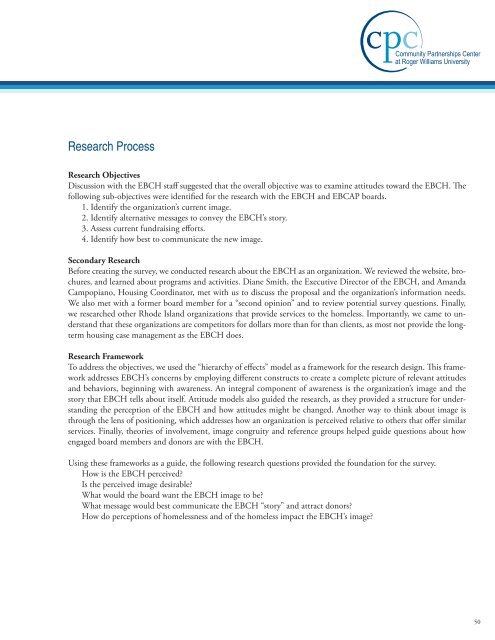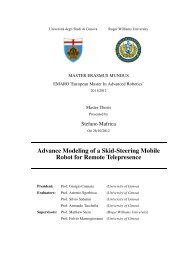East Bay Coalition for the Homeless - Roger Williams University
East Bay Coalition for the Homeless - Roger Williams University
East Bay Coalition for the Homeless - Roger Williams University
You also want an ePaper? Increase the reach of your titles
YUMPU automatically turns print PDFs into web optimized ePapers that Google loves.
Research Process<br />
Research Objectives<br />
Discussion with <strong>the</strong> EBCH staff suggested that <strong>the</strong> overall objective was to examine attitudes toward <strong>the</strong> EBCH. The<br />
following sub-objectives were identified <strong>for</strong> <strong>the</strong> research with <strong>the</strong> EBCH and EBCAP boards.<br />
1. Identify <strong>the</strong> organization’s current image.<br />
2. Identify alternative messages to convey <strong>the</strong> EBCH’s story.<br />
3. Assess current fundraising ef<strong>for</strong>ts.<br />
4. Identify how best to communicate <strong>the</strong> new image.<br />
Secondary Research<br />
Be<strong>for</strong>e creating <strong>the</strong> survey, we conducted research about <strong>the</strong> EBCH as an organization. We reviewed <strong>the</strong> website, brochures,<br />
and learned about programs and activities. Diane Smith, <strong>the</strong> Executive Director of <strong>the</strong> EBCH, and Amanda<br />
Campopiano, Housing Coordinator, met with us to discuss <strong>the</strong> proposal and <strong>the</strong> organization’s in<strong>for</strong>mation needs.<br />
We also met with a <strong>for</strong>mer board member <strong>for</strong> a “second opinion” and to review potential survey questions. Finally,<br />
we researched o<strong>the</strong>r Rhode Island organizations that provide services to <strong>the</strong> homeless. Importantly, we came to understand<br />
that <strong>the</strong>se organizations are competitors <strong>for</strong> dollars more than <strong>for</strong> than clients, as most not provide <strong>the</strong> longterm<br />
housing case management as <strong>the</strong> EBCH does.<br />
Research Framework<br />
To address <strong>the</strong> objectives, we used <strong>the</strong> “hierarchy of effects” model as a framework <strong>for</strong> <strong>the</strong> research design. This framework<br />
addresses EBCH’s concerns by employing different constructs to create a complete picture of relevant attitudes<br />
and behaviors, beginning with awareness. An integral component of awareness is <strong>the</strong> organization’s image and <strong>the</strong><br />
story that EBCH tells about itself. Attitude models also guided <strong>the</strong> research, as <strong>the</strong>y provided a structure <strong>for</strong> understanding<br />
<strong>the</strong> perception of <strong>the</strong> EBCH and how attitudes might be changed. Ano<strong>the</strong>r way to think about image is<br />
through <strong>the</strong> lens of positioning, which addresses how an organization is perceived relative to o<strong>the</strong>rs that offer similar<br />
services. Finally, <strong>the</strong>ories of involvement, image congruity and reference groups helped guide questions about how<br />
engaged board members and donors are with <strong>the</strong> EBCH.<br />
Using <strong>the</strong>se frameworks as a guide, <strong>the</strong> following research questions provided <strong>the</strong> foundation <strong>for</strong> <strong>the</strong> survey.<br />
How is <strong>the</strong> EBCH perceived<br />
Is <strong>the</strong> perceived image desirable<br />
What would <strong>the</strong> board want <strong>the</strong> EBCH image to be<br />
What message would best communicate <strong>the</strong> EBCH “story” and attract donors<br />
How do perceptions of homelessness and of <strong>the</strong> homeless impact <strong>the</strong> EBCH’s image<br />
50
















